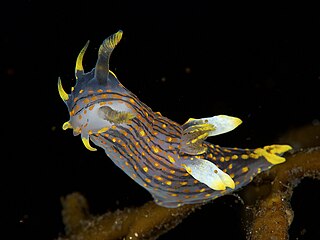Bruchia bolanderi is a rare plant of the Western U.S.: Oregon, California, and Nevada. It grows on very damp bare soil. One may distinguish it from other mosses by the capsules, which are shaped like little upside-down pear fruits.

Victor R. Ambros is an American developmental biologist who discovered the first known microRNA (miRNA). He is a professor at the University of Massachusetts Medical School in Worcester, Massachusetts.

Pomatias elegans, common name the round-mouthed snail, is a species of small land snail with an operculum, a terrestrial gastropod mollusk in the family Pomatiidae within the superfamily Littorinoidea, the winkles and their allies.

Polycera is a genus of sea slugs, specifically nudibranchs, shell-less marine gastropod molluscs in the family Polyceridae.
Bruchiaceae is a family of haplolepideous mosses (Dicranidae) in the order Dicranales. They have the greatest occurrence in temperate regions. They are mosses with long-necked, cleistocarpous capsules and mitrate calyptras.
Cyclostoma is an obsolete genus name of operculate snails with circular aperture.
Prioniodus is an extinct genus of conodonts in the family Balognathidae from the Ordovician.
Clavagella is a genus of marine bivalves in the family Clavagellidae.
Semotivirus is the only genus of viruses in the family Belpaoviridae. Species exist as retrotransposons in a eukaryotic host's genome. BEL/pao transposons are only found in animals.

Bruchia is a genus of haplolepideous mosses (Dicranidae) in the family Bruchiaceae.
Bruchia is a genus of beetles in the tribe Chalepini.
Cytochrome P450, family 14, also known as CYP14, is a nematoda cytochrome P450 monooxygenase family. The first gene identified in this family is the CYP14A1 from the Caenorhabditis elegans. The function of most genes in this family is unknown.
Bruchia armata is a species of beetle found in the family Chrysomelidae. It is found in South America. It is also named as being found in 2007.
Bruchia fulvipes is a species of beetle found in the family Chrysomelidae. It is found in Middle and South America.
Bruchia fulvipes was scientifically described for the first time in 1885 by Baly.
Bruchia sparsa is a species of beetle found in the family Chrysomelidae. It is found in South America.



